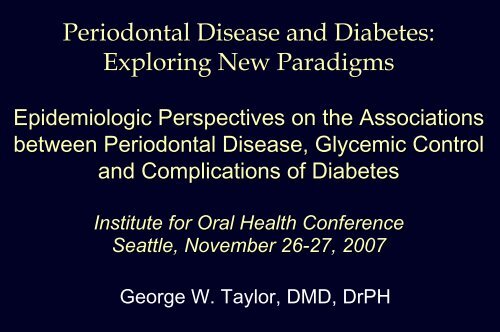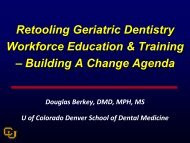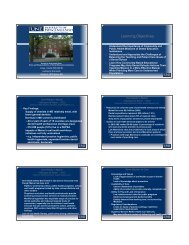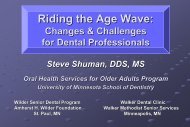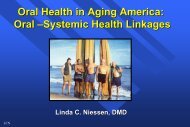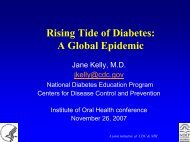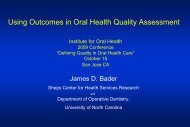PPT - Institute for Oral Health
PPT - Institute for Oral Health
PPT - Institute for Oral Health
- No tags were found...
Create successful ePaper yourself
Turn your PDF publications into a flip-book with our unique Google optimized e-Paper software.
Periodontal Disease and Diabetes:Exploring New ParadigmsEpidemiologic Perspectives on the Associationsbetween Periodontal Disease, Glycemic Controland Complications of Diabetes<strong>Institute</strong> <strong>for</strong> <strong>Oral</strong> <strong>Health</strong> ConferenceSeattle, November 26-27, 27, 2007George W. Taylor, DMD, DrPH
Diabetes and <strong>Oral</strong> <strong>Health</strong>Periodontal diseasesTooth LossDental CariesXerostomia<strong>Oral</strong> Candidiasis<strong>Oral</strong> Lichen PlanusBurning Mouth Syndrome
Diabetes Mellitus and Periodontal Diseases
OverviewOverview of periodontal diseases distributionDiabetes and periodontal healthInflammation, insulin resistance, and diabetesPeriodontal infection and insulin resistancePeriodontal infection and glycemic controlObservational studiesTreatment studiesPeriodontal disease and complications ofdiabetesConclusions
OverviewConceptual model <strong>for</strong> relationships betweenchronic inflammation, insulin resistance anddiabetesEpidemiological evidence <strong>for</strong> inflammationassociated with the occurrence of insulinresistance and diabetesPeriodontitis and insulin resistance in the U.S.populationPeriodontitis and glycemic control in the U.S.population
Periodontal diseases Chronic inflammatory disease Bacterial etiology Gram negative anaerobes are prominent Destruction of periodontal tissues Formation of pathologic pockets around teeth Loss of connective tissue attachment Loss of alveolar bone Can lead to tooth loss Chronic source of systemic challenge Bacterial products (e.g. LPS) Inflammatory mediators
GingivitisPeriodontitis Bacterial plaque Initial periodontaldisease Inflamed gingiva Reversible Can progress ifuntreated Bacterial plaque Advancedperiodontal disease Connective tissueloss Periodontalligament loss Supporting boneloss
Periodontal Diseases in the U.S.Adult Population
Gingivitis and severe periodontal diseaseprevalence (1+ sites with LPA 6+ mm)60504058544853 535556LPA6mm+GingivitisPercent3020100302319140 3 718-24 25-34 35-44 45-54 55-64 65-74 75+AGESource: NHANES 3 (1989-94), US Population
Diabetes and Periodontal <strong>Health</strong>Number of studies: smallest dot= 1 or 2; Middle sized dot= 4-5; Largest dot= 27
GradeABCDLevel1a1b1c2a2b2c3a3b45Type of EvidenceSystematic review (SR) of RCT’sIndividual RCTAll or noneSR of cohort studiesIndividual cohort study“Outcomes” researchSR of case-control studiesIndividual case-control studyCase series, cross sectional studyExpert opinionSource: Cochrane Collaboration, 1999
1a1b1c2a2b2c3a3b45Diabetes adversely affects periodontal health:Level ofevidence2b: cohortstudy4: x-sect,descr.Status of the evidence, 2007Type 1 Type 2 Type1,23/3 5/5 0 0GDMTypeUnkTotal0 8/817/18 7/10 10/13 2/2 8/9 44/52Total 20/21 12/15 10/13 2/2 8/9 52/60
Proposed explanatory mechanisms ofthe diabetes periodontitis association Altered host response Alterations in connective tissue Microangiopathy Alterations in gingival crevicular fluid Altered subgingival microflora Hereditary predisposition
Prevalence of periodontal disease in childrenand adolescents: type 1 diabetes121010864220Type1: N=142 NoDM: N=11611-18 Years OldSource: Cianciola et. al., JADA, 1982.
%Children and adolescents with 1+ sites with periodontalattachment loss ≥ 2mm. (Lalla E et al. 2006)
Severe periodontal disease prevalence:Swedish adults, ages 20-70, type 1 diabetes2523201815131050General Population Type 1 (SD) Type 1 (LD)SD=Short Duration Mean= 5.2yrs +/- 1.9 yrsLD=Long Duration Mean= 28.9yrs +/- 10.2 yrsSource: Thorstensson, 1995
U.S adults, ages 45+, with severe, “active”periodontitis* by glycemic control status1615.11412108644.36.020No DM Better Cntrl Poorer CntrlSource: NHANES III *1+ sites: LPA 6+ mm and gingival bleeding
Incidence of Alveolar Bone Loss after ~2yrs Follow-up in the Pima Indians1009080NoDM: n=338HbA1 < 9%: n=14HbA1 9%+ : n=7867060504060434157302010140NoneSomeSource: Taylor et al., 1998
Inflammation, Insulin Resistance andDiabetes
Supporting epidemiologic evidenceInflammation and insulin resistanceInsulin resistance and diabetesInflammation and diabetesPeriodontitis and sytemic inflammation/acute-phase responsePeriodontitis and insulin resistance
Supporting epidemiologic evidenceInflammation and insulin resistanceInsulin resistance and diabetesInflammation and diabetesPeriodontitis and sytemic inflammation/acute-phase responsePeriodontitis and insulin resistance
Supporting epidemiologic evidenceCross sectional studies: associations in peoplewithout diabetes or with metabolic syndromeSubjects without diabetes, general population,or those with IGT/IFGCorrelation of acute-phase reactants and proinflammatorymediators (CRP, IL6 and TNFα) with: Measures of insulin resistance/plasma insulinTriglycerides and HDL cholesterolIncreasing number of components of the metabolicsyndrome
Supporting epidemiologic evidenceCross sectional studies: associations in peoplewith diabetesSubjects with newly diagnosed or established type 2diabetes compared to controls without diabetesElevated acute-phase reactants (CRP, IL6 and TNFαCorrelation between HOMA and markers ofinflammation:CRP, serum amyloid A, secretory phospholipaseA2, IL6,TNFα, and endothelial dysfunction (soluble cell adhesionmolecules)
Supporting epidemiologic evidenceInflammation and insulin resistanceInsulin resistance and diabetesInflammation and diabetesPeriodontitis and sytemic inflammation/acute-phase responsePeriodontitis and insulin resistance
Supporting epidemiologic evidenceLongitudinal studies: markers of inflammationpredicting type 2 diabetes:ARIC : WBC, low serum albumin, α1-acidglycoprotein, fibrinogen, sialic acid US Women’s <strong>Health</strong> Study: CRP, IL-6US Cardiovascular <strong>Health</strong> Study: CRPPima Indians: WBC, adiponectinUS Insulin Resistance and Atherosclerosis Study: CRP,fibrinogen, PAI-1West of Scotland Coronary Prevention Study: CRP
Supporting epidemiologic evidenceLongitudinal studies: markers of inflammationpredicting type 2 diabetes (con’t.):NHANES: WBCHoorn Study in the Netherlands:CRPEuropean Prospective Investigation into Cancer andNutrition-Postdam Study: IL-6, IL-1βMONICA Augsburg Study: CRPMexico City Diabetes Study: CRP (signif. in men only)
Supporting epidemiologic evidenceInflammation and insulin resistanceInsulin resistance and diabetesInflammation and diabetesPeriodontitis and systemic inflammationPeriodontitis and insulin resistance
Periodontal therapy: effects on systemic inflammation Improved endothelialfunctionSeinhost et al., 2005Elter et al., 2006Tonetti et al., 2007 CRP level reducedSeinost et al., 2005D’Aiuto et al., 2005Ebersole et al., 1997 IL-6 levels reducedD’Aiuto et al., 2005Iwamoto et al., 2003 TNFα levels reducedIwamoto et al., 2003
Supporting epidemiologic evidenceInflammation and insulin resistanceInsulin resistance and diabetesInflammation and diabetesPeriodontitis and sytemic inflammation/acute-phase responsePeriodontitis and insulin resistance
Why do we think periodontal disease islinked to insulin resistance and glycemiccontrol?
Chronic inflammationVisceral obesityIl-6TNFαProinflammatory stateChronic overexpression ofcytokinesPancreaticbeta celldamageLiverInsulin resistanceAcute PhaseResponse (CRP,Fibrinog., PAI-1)GlycemicControlConceptual Model: From Richard Donahue, 2004
Periodontitis and Insulin Resistance:Epidemiologic Evidence of an Association
Periodontitis and Insulin Resistance in U. S.Adults, NHANES III, Preliminary ResultsTo evaluate the association between severeperiodontitis and insulin resistance in arepresentative sample of U.S. adults, ages17-90 years old.
STUDY POPULATION Participants of the ThirdNational <strong>Health</strong> andNutrition ExaminationSurvey (NHANES III) Data collected between1988-1991 and 1992-1994to provide nationalestimates in studying oraland systemic health. Non-smokers, [nodiabetes] or [diabetes andno meds <strong>for</strong> diabetes].DATA SOURCES Face-to-face interview Comprehensive oral exam Medical exam Laboratory assays
MAJOR EXPOSURESevere periodontitisAt least 1 site with 6mm or more ofattachment loss&Gingival bleeding atthe teeth with 6+mm of attachmentlossOUTCOMEInsulin ResistanceHOMA <strong>for</strong>mulaFasting insulin (FI)Fasting glucose (FG)FI x FG22.5Dichotomous variableusing the 80 thpercentile as thecutpoint
Association between severe periodontitis andinsulin resistance (HOMA 80 th ): crude odds ratioN= 5313Severe periodontitis (sPD+): n=281 (5.3%)sPD- /HOMA80+: n=1474 (24.6%)sPD+ /HOMA80+: n=100 (38.7%)Crude Odds Ratio: 2.3 (1.58, 3.39)
Logistic regression modelResponse: HOMA 80 thth (n=1574/5313)COVARIATE OR 95% CISevere perio. 1.74 1.01, 3.0BMI (>27) 4.77 4.1, 5.6HDL (≤40) 2.2 1.7, 2.9TRIG (>200) 2.7 2.0, 3.6CRP 1.3 1.1, 1.5Diabetes 4.72 2.6, 8.4Other covariates controlled in model were age,race/ethnicity, exercise, white blood cell count, fibrinogen.
Periodontal InfectionIts Effect on Glycemic Control:Summarizing the Empirical Evidence
Periodontal InfectionIts Effect on Glycemic Control:Observational Studies
Observational Evidence: Incidence of poorer glycemiccontrol at ~2-yrs. follow-up in Pima Indians605050Bone loss < 50%Bone loss 50%+40383020101320 185020-34 35-44 50-64Source: Taylor et al., 1996Age GroupsN <strong>for</strong> bone loss < 50% = 56N <strong>for</strong> bone loss 50%+ =49
Effect of severe bone loss on follow-upHbA1 at 9%+PREDICTORBone lossODDS RATIO(95% CI)25 year old 13.6 (1.7, 106.0)35 year old 4.2 (1.2, 14.9)50 year old 0.71 (0.2, 2.9)HbA1 (baseline) 1.9 (1.1, 3.5)
Observational Evidence: Change in HbA1c byperiodontal disease status in adults with type 2diabetes, ages 58-769.59.298.88.7HbA1c%8.587.9BL HbA1cFU HbA1c7.57No/Mod Perio n=15 Adv Perio n=10Periodontal StatusSource: Collin et al., 1998
Prevalence of poorer glycemic control inU.S. adults, ages 45+, by periodontal status*706061Better control: n=309Poorer control: n=22659% of Persons504030201039410No Sev. Perio.Sev. PerioSource: NHANES III (1989-94), US PopulationPeriodontal Disease Status* Sev. Perio=1+ site w LPA 6 mm+, gingival bleeding
Association between severe periodontitis andglycemic control: N=535Crude Odds Ratio: 3.20 (1.47, 6.98)Glycemic ControlPeriodontal StatusBetterHbA1c < 8%PoorerHbA1c ≥ 8%Sev. Perio: NO 270 (61%) 170 (39%)Sev. Perio: YES 39 (41%) 56 (59%)
Logistic regression model: poor glycemic control in U.S.adults, ages 45+, non-smoking, NHANES IIICOVARIATE OR 95% CISevere perio. 4.9 2.0, 11.9Taking Diab med 3.4 1.7, 5.8BMI (≥ 27) 2.6 1.2, 5.4TRIG (>200) 2.7 2.0, 3.6CRP (>1.0) 2.6 0.5, 13.8Exercise 1.0 0.99, 1.01Other covariates controlled in model were age,race/ethnicity, sex, education, poverty income ratio, andMD and DDS visits.
Periodontal Infection:Effect on Glycemic ControlBeyond observational studies
GradeABCDLevel1a1b1c2a2b2c3a3b45Type of EvidenceSystematic review (SR) of RCT’sIndividual RCTAll or noneSR of cohort studiesIndividual cohort study“Outcomes” researchSR of case-control studiesIndividual case-control studyCase series, cross sectional studyExpert opinionSource: Cochrane Collaboration, 1999
Periodontal InfectionIts Effect on Glycemic Control:Non-surgical PeriodontalTreatment Studies
Locations of clinical therapeutic studiesNWES
Non-surgical periodontal therapy studies:Organizing the evidenceRandomized clinical trials (RCT)Non-treated control group: 1 positive/3 studiesPositive control group:Usual source of care3 positive/3 studies0 positive/1 studyNon-randomized clinical treatment studies (non-RCT)Non-treated control group:No control group:1 positive/2 studies7 positive/10 studies
Non-surgical periodontal therapy: a meta-analysis.analysis.Janket et al. J Dent Res, 2005
Clinical Study DM Effect NRCT: non-tx controlsAldridge et al. (1995) 1 N 31Aldridge et al. (1995) 1 N 22Kiran et al. (2005) 2 Y 44RCT: usual care controlsJones et al. (2007) 2,7 2 N 165RCT: positive controlsGrossi et al. 2 (1996) 2 Y 104Rodrigues et al. 4 (2003) 2 Y * 30Skaleric et al. 3 (2004) 1 Y 201=Penicillin; 2=Systemic doxycycline; 3=Minocycline, locallydelivered4=Amoxicillin and augmentin; 5=Systemic doxycycline: non-
Significance of improving of glycemic controlAny sustained lowering of blood glucose helpsdelay the onset and progression of microvascularcomplications of diabetesPrevalence of complications in people with diabetes Neuropathy – 50% Any cardiovascular disease – 38% Coronary heart disease – 22% Stroke – 21% Visual Impairment – 23% Kidney disease – 40% of new cases of renal failure due todiabetes
Landmark clinical trials demonstrating thesignificance of improving of glycemic controlDiabetes Control and Complications Trial (DCCT)Intensive blood glucose control in type 1 diabetes35% to 70% reduction in risk of retinopathy,nephropathy and neuropathyUK Prospective Diabetes Study (UKPDS)Intensive blood glucose control in type 2 diabetes12% to 33% reduction in risk of retinopathy andnephropathy
Periodontal infection and complications of diabetesThorstensson et al., 1996; J Clin Periodontol.39 case-control pairs, type 1 and type 2 diabetesCases (severe periodontal disease) had greaterrisk <strong>for</strong>ProteinuriaCardiovascular complications: stroke, TIA,angina, myocardial infarction, andintermittent claudication
Periodontal infection and complications of diabetesSaremi et al., 2005; Diabetes Care.Prospective cohort study of n=628, type 2diabetesSevere periodontal disease: 3.2x greater risk <strong>for</strong>cardiorenal mortality (ischemic heart disease andnephropathy)Controlled <strong>for</strong> established risk factors:age, sex, duration, BMI, hypertension, bloodglucose, cholesterol, ECG abnormalities,macroalbuminuria, and smoking
Periodontal infection and complications of diabetes:Overt nephropathy and ESRDShultis et al., 2007; Diabetes Care.Prospective cohort study of n=529, type 2 diabetesSevere periodontal disease associated with incidence ofmacroalbuminuria and ESRD adjusted <strong>for</strong> age and sexMAESRD
Periodontal infection and complications of diabetes:Overt nephropathy and ESRDShultis et al., 2007; Diabetes CareMacroalbuminuriaHRRMod Perio: 2.0 (1.2-3.5)Sev Perio: 2.1. (1.2-3.8)Edent: 2.6 (1.4-4.6)n=193/529ESRDHRRMod Perio: 2.3 (0.6-8.1)Sev Perio: 3.5 (0.96-12.4)Edent: 4.9 (1.4-17.4)n=68/529Proportional Hazards Model: Adjusted <strong>for</strong> Age, Sex,Diabetes Duration, BMI, and Smoking
Conclusions Consistent, world-wide evidence that diabetesadversely affects periodontal health Evidence that chronic periodontitis may potentiateinsulin resistance Evidence that treating periodontal infection can: Lead to improved glycemic controlPossibly prevent, delay, or reduce severity ofcomplicationsPossibly prevent the development of diabetes itself
Acknowledgements University of Michigan School of DentistryWenche S. Borgnakke, DDS, PhDMichael C. Manz, DDS, DrPH Case School of Dental MedicineMonica A. Fisher, DDS, PhDUniversity of the Virgin IslandsChrisna ThomasNational Center <strong>for</strong> <strong>Health</strong> Statistics
Thank you <strong>for</strong> your attentionPlease feel to contact meGeorge W. Taylorgwt@umich.eduUniversity of Michigan School of Dentistry


